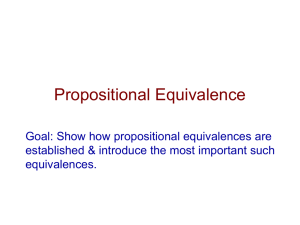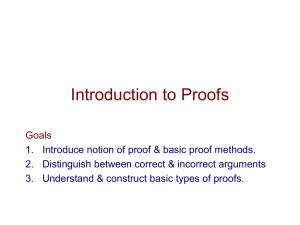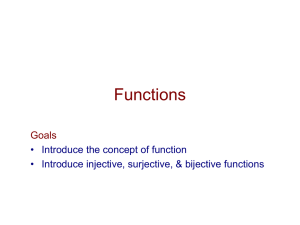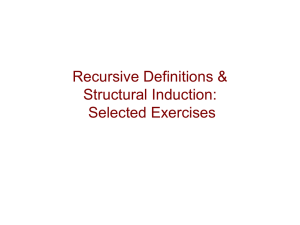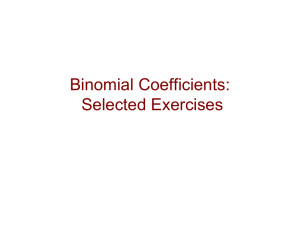3.4e - UCSB Computer Science
advertisement
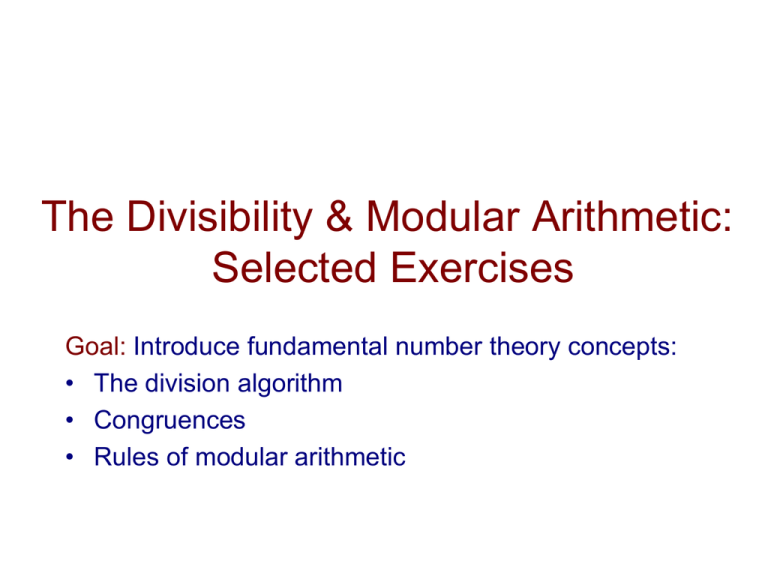
The Divisibility & Modular Arithmetic:
Selected Exercises
Goal: Introduce fundamental number theory concepts:
• The division algorithm
• Congruences
• Rules of modular arithmetic
Exercise 10
Division Algorithm: Let a Z, d Z+. !q !r ( 0 r < d a = dq + r ).
What are the quotient & remainder when:
a)
44 is divided by 8?
q: 5,
r: 4.
b)
777 is divided by 21?
q: 37,
r: 0.
c)
-123 is divided by 19?
q: -7,
r: 10. (not q = -6, r = -9)
d)
-1 is divided by 23?
q: -1,
r: 22.
e)
-2002 is divided by 87?
q: -24,
r: 86.
f)
0 is divided by 17?
q: 0,
r: 0.
g)
1,234,567 is divided by 1001? q: 1233, r: 334.
h)
-100 is divided by 101?
q: -1,
r: 1.
Remember: remainders are always nonnegative.
Copyright © Peter Cappello
2
Exercise 34
Thm. 4. Let m Z+ & a, b Z.
a is congruent to b modulo m, denoted a ≡ b ( mod m ),
k Z ( a = b + km ).
( m | (a – b) )
Show:
if a ≡ b ( mod m ) and
c ≡ d ( mod m ), where a, b, c, d, m Z with m ≥ 2,
then a – c ≡ b – d ( mod m ).
Copyright © Peter Cappello
3
Exercise 20 Solution
Notation: a is congruent to b modulo m is denoted a ≡ b ( mod m )
Thm 4. Let m Z+. a ≡ b ( mod m ) k Z, a = b + km.
( m | (a – b) )
Show:
if
a ≡ b ( mod m ) and c ≡ d (mod m),
where a, b, c, d, m Z with m ≥ 2,
then a – c ≡ b – d ( mod m ).
Proof (Direct)
1.
Assume ka Z, a = b + ka m
( Thm 4: a ≡ b (mod m) )
2.
Assume kc Z, c = d + kc m
( Thm 4: c ≡ d (mod m) )
3.
a – c = b – d + (ka – kc )m
( 1. – 2. )
4.
a – c ≡ b – d ( mod m )
( 3. & Thm 4 )
Copyright © Peter Cappello
4
Generating Pseudo-random
Numbers
• Generating pseudo-random numbers has important
applications.
• One application area is the Monte Carlo Method.
– Wikipedia
– MathWorld
• We glimpse 2 Monte Carlo Method applications crucial
to the survival of the human species.
– Approximate π
– Approximate winning probabilities in Texas Hold’em
Copyright © Peter Cappello
5
Approximate π
Via the Monte Carlo Method
(throwing darts)
1
ACIRCLE = π r2 = π / 4
1/2
ASQUARE = 1
1
ACIRCLE
---------- = π / 4
ASQUARE
Copyright © Peter Cappello
6
(½ , ½ )
( x, y )
If ( x2 + y2 ≤ 1/4 )
then (x, y) is “in” circle.
(0, 0 )
(- ½ , - ½ )
½
Copyright © Peter Cappello
7
Use the Monte Carlo Method
Approximate π : via the Monte Carlo method:
double approximatePi( int n )
{
int inCircle = 0;
for ( int i = 0; i < n; i++ )
{
double x = rand( 0, 1 );
double y = rand( 0, 1 );
if ( isInCircle( x – 0.5, y – 0.5 ) )
inCircle++;
}
return ( 4.0 * inCircle ) / n; // value is a double
}
Copyright © Peter Cappello
8
boolean inCircle( double x, double y )
boolean isInCircle( double x, double y )
{
return x*x + y*y <= 0.25;
}
Copyright © Peter Cappello
9
Texas Hold 'em
• “Probability” they given that a player will win hand is approximate.
• They use the Monte Carlo method:
• n times: Randomly guess 5 community cards.
– For each guess, compute the winner.
– Increment his/her winCount: winCount[ winner ]++
• Playeri approximate probability of winning: winCount[ i ] / n.
Copyright © Peter Cappello
10
30: Pseudorandom numbers
The linear congruential method uses:
1. a modulus (m), m ≥ 2,
2. a multiplier (a), 2 a < m
3. an increment (c), 0 c < m
4. a seed (x0), 0 x0 < m
It generates the sequence { xn } using the recurrence
xn+1 = ( a xn + c ) mod m.
Write an algorithm in pseudocode for generating a
sequence of pseudorandom numbers using a linear
congruential generator.
Copyright © Peter Cappello
11
Exercise 30 continued
The input is:
1. a modulus
2. a multiplier
3. an increment
4. a seed
5. the number ( n ) of pseudorandom numbers
The output is the sequence { xi }.
Copyright © Peter Cappello
12
Exercise 30 continued
int[] pseudorandom( int modulus, int multiplier, int increment, int seed, int n )
{
assert modulus > 1;
assert 2 <= multiplier && multiplier < modulus;
assert 0 <= increment && increment < modulus;
assert 0 <= seed && seed < modulus;
int[] x = new int[ n ];
x[0] = seed;
for ( int i = 1; i < n; i++ )
x[ i ] = ( multiplier *x[ i – 1 ] + increment ) % modulus;
return x;
}
Copyright © Peter Cappello
13
End
14


